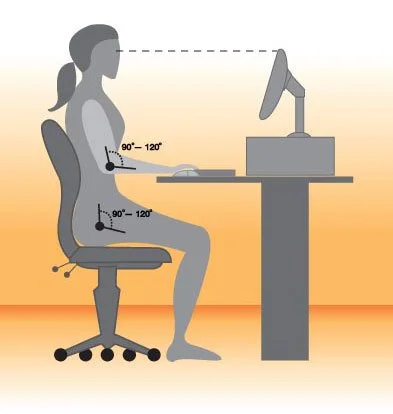5- Step System to avoid pain at your desk.
We’ve all heard about it or felt it before – an aching neck after sitting at the computer for too long or a sore low back from prolonged sitting. It could be just a little discomfort or it could be actual pain that’s affecting your productivity. Regardless of which, there are lots of ways you can avoid pain at your desk to make life more comfortable! This week at Goolwa Physio we’re going to run you through our 5-step system to avoid pain at your desk.
01. Take a photo
How do you really know what your posture is like without seeing yourself sitting at your desk! Getting someone to take a photo of you at your desk is a great way to assess your posture and identify areas that can be improved. A photo will also provide you with a baseline, which you can compare to later when you’ve improved your ergonomic set up.
02. Check your computer height and neck position
Usually after someone has taken a photo you’ll see yourself slouched in your chair with your shoulders rounded and chin poking forward. This posture is a classic trigger of neck pain, shoulder pain and headaches. We recommend adjusting your monitor height so the height of the screen is level with your eyes. If you use a laptop getting an external keyboard so you can raise the laptop monitor up can be helpful.
03. Have a look at your back.
If you are spending a lot of time sitting at a desk your natural lumbar curve is usually flattened. Using a lumbar support in your chair helps to promote this inward curve and can reduce backache. Also think about raising or lowering your chair, depending on your height, so your feet are flat on the floor and your knees and hips are bent at 90degrees.
04. Motion is lotion.
If you’re sitting at your desk for longer than an hour it’s best to get up and move around. Our bodies are designed to move so any prolonged position can trigger pain. A quick lap around the office will keep your blood flowing and muscles pumping which helps to clear waste products from the tissues, thereby reducing the aching feeling you get. Doing simple stretches throughout your working day also helps to loosen up tight muscles and promote good circulation. Simple stretches include rolling your shoulders forward and back, tilting your head side to side, bending and straightening your knees and twisting side to side in your chair. Goolwa Physio recommend doing 5-10 repetitions of each exercise several times per day.
05. Limit screen time
If you are on your computer for hours during the day try to limit your screen time when you’re not working. Prolonged screen time is a common culprit when it comes to headaches. Instead of screen time read a book, get some fresh air outside or listen to calm music. Doing these things before you go to bed can promote good sleep patterns which will in turn increase your productivity at work.


